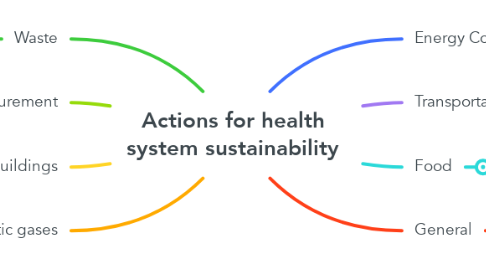
1. Waste
1.1. Switching from single-use to reusable medical devices. Easier to implement/products might already exist specific tools for surgeons, sterile cloths, sterile gowns, and heat blankets. More difficult to implement because products might not exist: Gloves, medical face masks. Challenges concerning the sterilisation process need to be addressed. Mid/Long-term
1.2. Reduce waste from single use gloves by educating staff about situations in which gloves are necessary or not. Provide hand disinfectant and possibility to wash hands in every hospital room. Mid/Long-term
1.3. Implement correct waste separation by providing different containers and educate staff on how to separate waste correctly. Ensure logistics are in place. Ensure recycling. Mid-term
1.4. Implement autoclaving and reusing of medical devices made of metal (for example sterile wound material used on the wards). Mid/Long-term
1.5. Printer setting always double-paged, use only recycling paper. Short-term
1.6. Switch from paper-based to electronic-based documentation. Mid/Long-term
1.7. Health benefit: Indirect impact via reduced manufacturing air/water emissions; direct impact on health sector via reduced costs; reduced direct impacts from air, water and soil pollution and GHG emissions, reduced impacts from water and soil pollution.
2. Procurement
2.1. Setting up sustainable procurement guidelines for the hospital. Buying only from manufacturers who comply with those guidelines (criteria could be climate neutrality, circular economy principles etc). Mid/Long-term
2.2. For some medical devices, it could be useful to outsource their usage: instead of buying medical devices, evaluate whether companies are already providing them and take care of maintenance problems, such as broken machines, in a circular way. Mid/Long-term
3. Buildings
3.1. Investing in sustainable buildings with adequate insulation. Long-term
3.2. Investing in solar panels. Long-term
3.3. Investing in green outdoor spaces. Long-term
3.4. Health impact: Improved indoor air quality and use of nontoxic materials.
4. Anaesthetic gases
4.1. If applicable, using less anaesthetic gases by opting for different types of anesthesia (e.g intravenous, spinal blocks) or reducing the fresh gas flow, when possible. Short-term
4.2. Banning anaesthetic gases with the worst greenhouse gas effect. Short-term
4.3. Implementing recycling strategies for anaesthetic gases. Mid/Long-term
5. Energy Consumption
5.1. Switch to Renewable Energies. (Public Health benefit: Less air pollution from burning fossil fuels – decreased mortality and morbidity.) Short-term
5.2. Improve Energy efficiency by
5.2.1. Ventilation: reduce power if feasible, optimize usage by installing presence detectors in operating rooms. Mid-term
5.2.2. Cooling: install automatic closing doors. Mid/Long-term
5.2.3. Heating: Increase the basic temperature if feasible. Use high efficiency heat pumps. Ensure good isolation. Mid/Long-term
5.2.4. Lightning: Switch to LED lamps, install presence detectors. Short/Mid-term
5.3. Health benefit: Indirect impact from the lowering of air pollutants and greenhouse gas emissions.
6. Transportation
6.1. Optimising scheduled appointments, so that the patient has to come less often to the hospital as in the example: patient comes once to meet the anaesthesiologist and the surgeon. Mid-term
6.2. Implementing digital preoperative consultations. Mid-term
6.3. Offering bicycle leasing options to employees. Short/Mid-term
6.3.1. Health benefit: Improving employees' health through more physical activity
6.4. Making hospital-owned vehicle fleet electrical. Mid/Long-term
6.5. Offering public transportation subscriptions to employees. Strengthen the bus and train accessibility by working with the municipality. Short/Mid-term
6.6. Health benefit: Indirect impact from the lowering of air pollutants and greenhouse gas emissions.
7. Food
7.1. Using local products to reduce emissions from transportation. Short/Midterm
7.2. Opting for plant-based food and reducing meat and animal-based products. Short-term
7.2.1. Health benefit: Less cardiovascular diseases.
7.3. Using digital tools to find out about patients’ preferences for their food before distributing it, to avoid food waste. Mid-term
7.4. Implement reusable boxes for To-go-food and drinks. Short-term
8. General
8.1. Emphasizing prevention medicine to avoid disease and, subsequently, diagnostic and treatment needs. Implementing strategies to keep staff healthy, for example by providing sport courses, counselling and reward for smoking cessation. On a policy level this would mean shifting health investments into prevention medicine. Long-term
8.1.1. Health benefit: Less mortality and less diseases.
8.2. Reducing unnecessary medical interventions. Implement clear diagnostic and treatment guidelines in the hospital and educational measures for doctors and medical students on how to avoid unnecessary diagnostics and interventions. Long-term
8.2.1. Health benefit: Less health complications from unnecessary diagnostics and interventions.
8.3. Investing in digitalization: Digital consultations and digital health records can help to save human resources, have all information readily available and thus avoid efforts and/or materials that have already taken place.
8.4. Investing in research: The medical field is only at the beginning of assessing their carbon footprint. Many things are yet unknown. E.g., which medications have a more sustainable supply chain? Together with sustainability engineers evaluate the most sustainable treatment options in health care. In the example of medications, set up a database to provide guidance to the purchasing department. Are there ways to implement circular economy in the hospital, by e.g., separating plastics directly in the hospital OR and involving the producing companies?
8.5. Involving the health care workforce: They know best what the everyday life looks like and they are the ones who need to implement the changes. They need to be involved directly from the beginning. Awareness, education and motivation are very important.
8.5.1. Health benefit: A healthy work environment with a good team spirit can be beneficial for the health care workers’ mental health.
